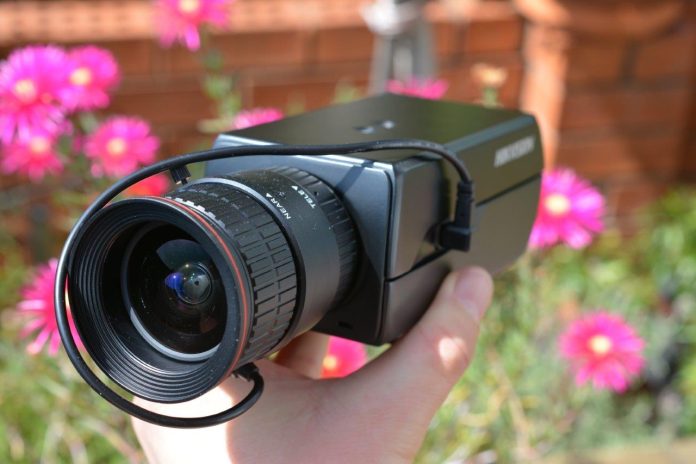Hikvision’s Darkfighter DS-2CD6020FHWD(-A), distributed locally by Central Security Distribution, is an ultra low light WDR 2MP IP camera with a ½-inch progressive scan CMOS sensor. The camera offers 60fps, 120dB WDR, a region of interest codec and 3D DNR digital noise reduction.
I’VE been keen to test Hikvision’s DarkFighter DS-2CD6020FHWD(-A) full body camera for a while now so it was a thrill when Hikvision’s Michael Bates and Tony Lagan turned up at the office one morning door laden with boxes containing the Darkfighter, a couple of lenses and Hikvision’s DS-7600 Linux embedded NVR.
Along with the Darkfighter, the boys also brought along a new SmartIP 4-Line 6MP full body camera that I wasn’t expecting to see. The idea of this was to allow some comparison during the test. Happening to have a brand new 6MP camera in your kitbag that no one’s heard of before strikes me as being a very Hikvision thing.
The idea here is to set up the Darkfighter in a challenging WDR situation and then note its low light performance as night falls. The appointed day of the test arrives and it’s a bright blue Sunday afternoon in Sydney. The period of the test kicks off around 330pm and runs until 830pm at night.
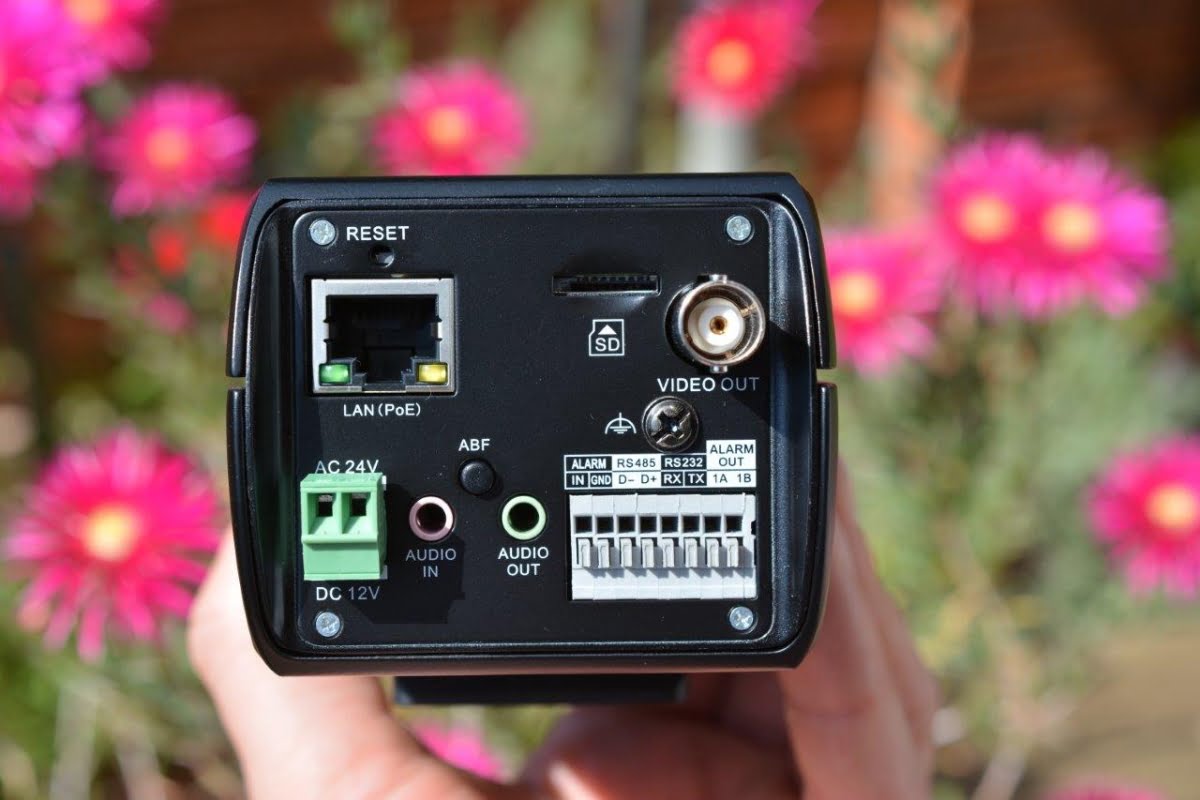
Stern of the Darkfighter
The test-jig at the office is simple. The DS-7600 is ported straight to an HP L2445w widescreen monitor using a converter cable and there’s a wee mouse to drive the NVR’s very simple GUI. Meanwhile, I’m also able to port into the NVR via browser and play with camera settings via my elderly HP EliteBook, which has an Intel Centrino dual core processor gasping away under the bonnet. Not surprisingly, the images look better direct from NVR to monitor and I stick with that configuration most of the time.
The Darkfighter is connected to the NVR via a 20m length of Cat-5 bought for the purpose from an electrical wholesaler. Just untangling the torturous loops this cable came wound up in puts white stress marks in the cable jacket. Quality Cat 5/6 cables are worth the price you pay for them, I think to myself.

Darkfighter’s 1/2-inch chip
The lenses I’m running for the test are Hikvision’s own 3.8-16mm F1.5 – an 8MP IR-corrected 1/1.8-inch (9.2mm) lens, as well as the 11-40mm @F1.5 1/1.8-inch 8MP IR-corrected lens which arrives mounted on the Hikvision SmartIP 4-Line 6MP. This 11-40mm gives a tighter, longer view and holding the both lenses gives a sense that the glass is good quality. The feel of the focus is smooth, the poly is heavy, the fixings are metal.
As well as being bright, the test scene is a complex and challenging one, with plenty of detail from front to back. We are looking out across the lower end of Surry Hills towards the CBD. As well as elements of the courtyard itself, there are surrounding towers, a lane, a row of houses, a line of treetops on the next street down, then commercial and residential towers at multiple distances, from 350m to 1500m away.
As I get underway, I measure the light level in full sun in the North-West facing courtyard at a monstrous 15.1 EV (90,000 lux). WDR is going to be nasty this afternoon, which is exactly as I want it to be. I start with Darkfighter camera looking from inside the office where light is 5.8 EV (160 lux) to the outside where light is 15.1 EV (90,000 lux) and sit down at the monitor.
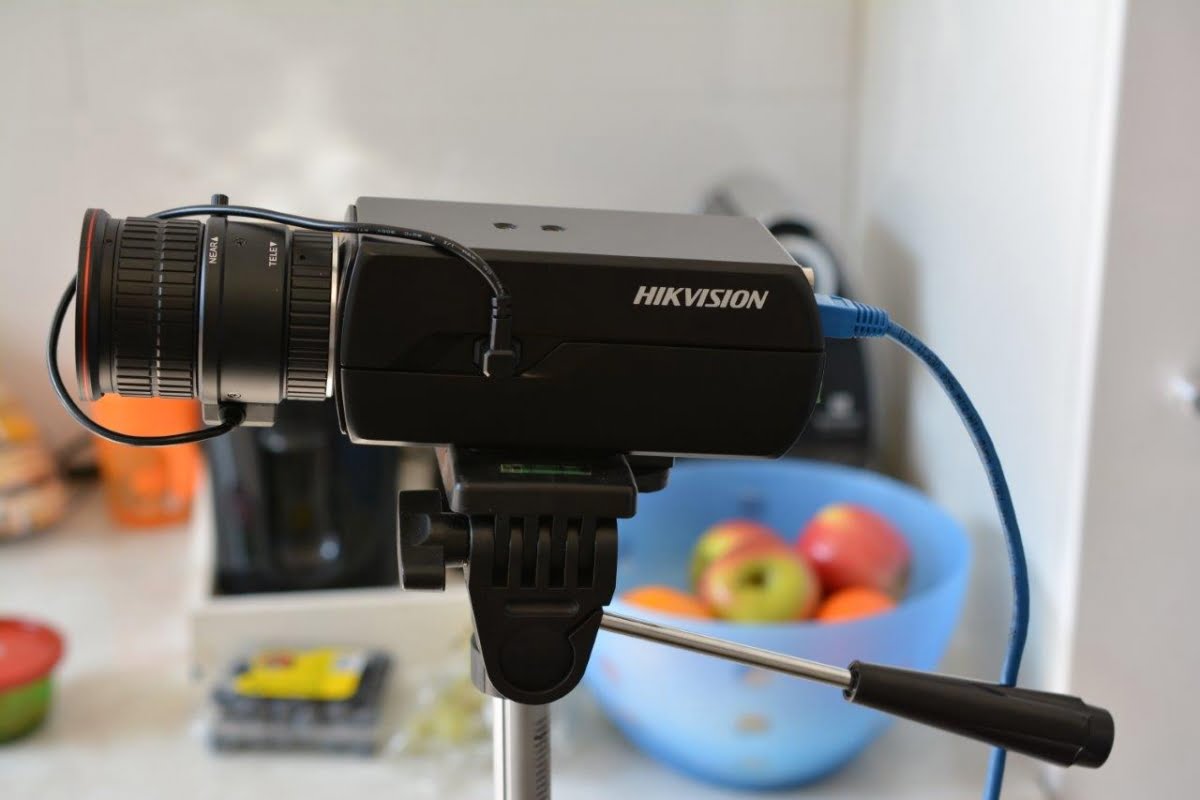
Setup for WDR test looking through open kitchen door at afternoon sun (external light level is 90,000 lux)
In this environment, Darkfighter does great work – it’s getting excellent detail and great colour into vicious backlight in a scene depth of around 10m using the short lens. Fine details of buildings at 350m are being ironed out by the backlight, but tones remain good at all times and overall depth of field is excellent. I test a face in the doorway and the Darkfighter handles that, while still giving great images into the courtyard and beyond.

Face recognition looking out door – image is surprisingly composite considering the tough conditions – bear in mind all recorded file sizes here are between 129 (this file) and 258Kb

Darkfighter facing 90,000 lux of afternoon sunlight
Comparatively, the 6MP 4-Line looking out the front window of the office onto a scene with plenty of movement is not quite as smooth. This camera is good with backlight but doesn’t do as good a job front to back of this nasty internal to external scene as Darkfighter is doing. In fact, I’m starting to wonder if Darkfighter is a misnomer.
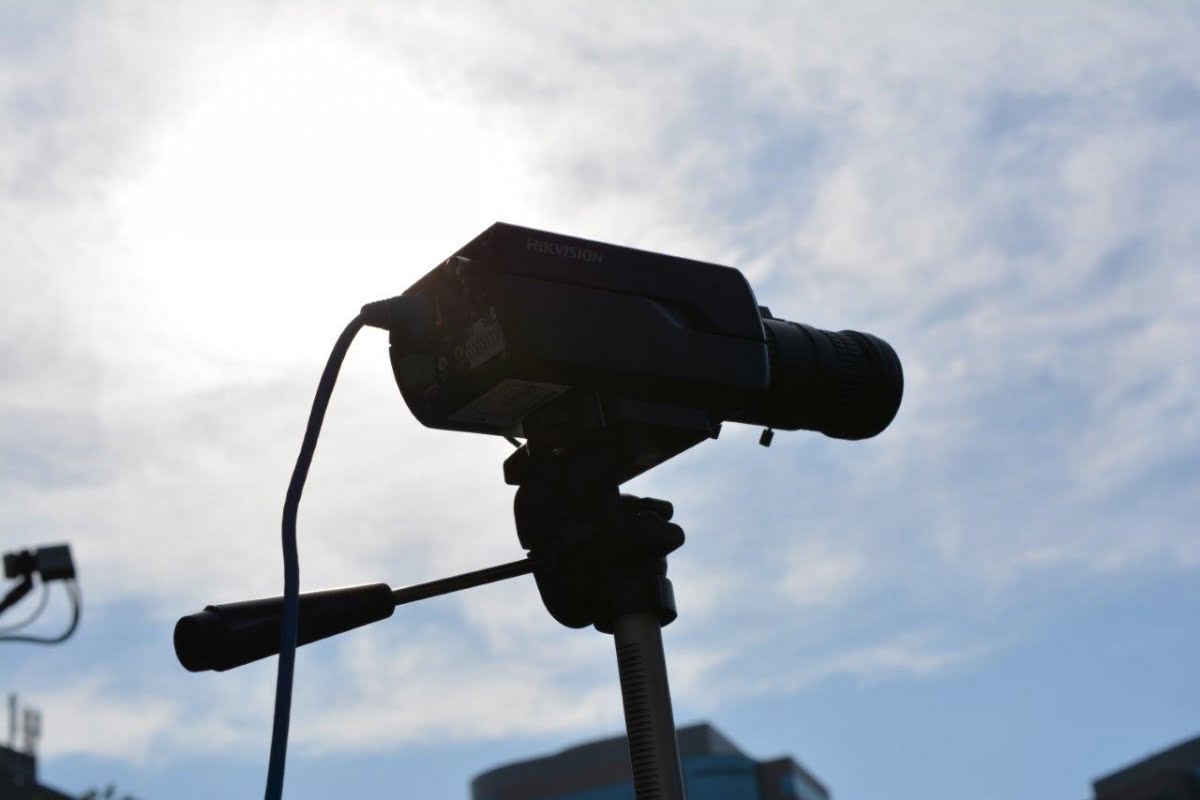
Nikon D7100 set to auto with flash off and a Nikkor 40mm F2.8 prime struggled with this view – sun is just above Darkfighter
Now I get deliberately unfair. I tilt Darkfighter’s lens to a point just under the sun, facing towards Central Station. It’s an intense challenge – no technician would install a camera at this silly angle to the afternoon sun – but Darkfighter handles it. There’s some flare from the lens, but it’s still a more than useable image.

Sun is right on the edge of the upper horizon putting some refraction flare across internal lens components – this is a difficult scene and Darkfighter is managing
Given the black-bodied Darkfighter is sitting out in full sun with no housing, something that’s on my mind is heat. Darkfighter is doing processing work under the surface and you can feel that work through the camera housing as heat once it’s been powered up for a while. It’s not as if the camera is too hot to touch – I can put the side of my face onto it – but it’s noticeably warmer than the SmartIP 4-Line 6MP.

Pushed to the north, the flare is gone, 90,000 lux sidelight is ignored. This is the wide angle view and there was a lot of movement in this scene
At about 4pm I turn the camera away from the sun towards the North. It’s a tight but complex scene about 60m deep. I can see the pleats in Fred’s shirts drying over the back fence, I’m getting details in the besa blocks of the Yaffa building 4 doors up, across the lane at about 25m I can see detail in brickwork, relections in glass, as well as details in city buildings 1000 metres away.
This is a strong image in bright (14.9 EV – 90,000 lux) sidelit conditions using a naked lens with no shroud. There’s a reasonable amount of movement too; with plants, washing, cars moving in the lane, and throughout this; the camera does well in real time. It’s not movie-reel smoothness but it’s a good stream. Overall the Darkfighter is exemplary with backlight. It’s not got the highest WDR levels on the market – around 120dB – but that’s a huge level for a camera that leans towards low light performance.
At about 4.30pm I switch the camera lenses over and run the 11-40mm tele on the Darkfighter (this gives me a chance to look at the big ½-inch sensor). The Darkfighter does well outside with the tele in what is still very strong sidelight of around 80,000 lux. Details at every distance greater than about 10m become much clearer with the longer lens mounted – it’s actually a nice match for this camera.
Many camera makers talk about ‘crystal clear’ images in their marketing material but given the constraints of lens quality, sensor size and compression artefacts introduced by the application of live ROI, crystal clear is probably not the right word to use. Instead, this image stream is surprisingly tight, holding detail-giving contrast deep into the scene. To give myself a comparison, I take a 7MP still image of the same view using a Nikon d7100 and a Nikkor 40mm f2.8 prime lens. When I compare this still image with the live image stream, the Darkfighter is by no means disgraced.
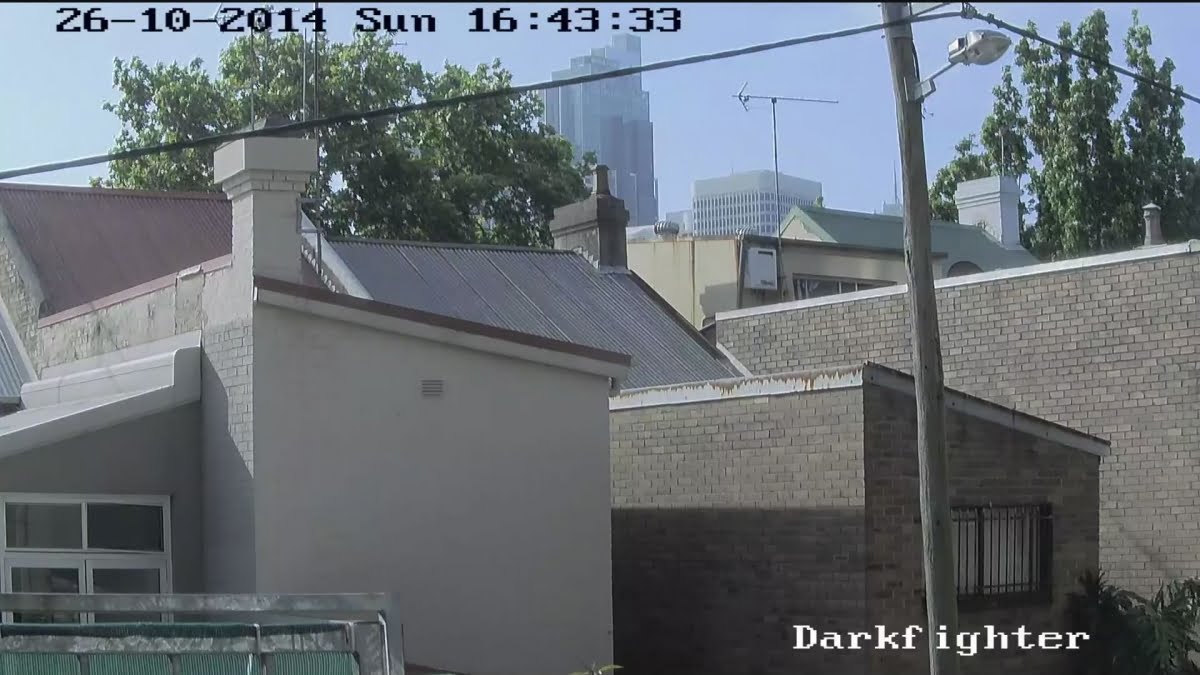
Darkfighter with the tele lens – note the detail in the gate bottom left and the World Square at 1000m. This lens is a good match for Darkfighter
Next, I tip the camera up to view Centrepoint Tower and again the detail throughout the depth of field I get from this Hikvision telephoto lens is surprising. It’s not the pin-sharp image of a super fast f1.4 FX camera lens but it’s not meant to be. Instead it’s a clean, integrated and progressive live video stream stretching across Bellevue Lane, over Belmore St and way off over Hyde Park to the World Square building at 1000m and Centrepoint Tower at 1500m. And while this long distance work is going on, Darkfighter is also picking up detail in a galvanised steel gate at a distance of 1.5m from the lens. Nice.
At 5pm the light is starting to soften – around 12.5-13 EV (14,500 to 20,500) – as clouds start coming over. At about 510pm I switch over to the 6MP and the wide angle lens. After setting up and running backfocus, I settle in to watch the live image and it’s quite interesting. The image is strong and the stream is smooth – the clouds move across the sky like silk. The sun drops behind a cloud and I lose a little detail in the shadows. I have a play with brightness – and ok then – that looks much better again.
Unsurprisingly, this wide angle lens has a shallower depth of field, it does nicely up close but you don’t get the strong detail you see with the longer lens. In this scene past about 30m or so the background starts softening into a sort of situational bokeh. You can sort this by tweaking the zoom in a test but it would not be so easy with the camera installed. Now I switch to the tele lens on the SmartIP 4-Line 6MP and point it towards Centrepoint – wowee, it’s good. It’s excellent. That’s the strongest long range image of the day. I can read the words World Square on the World Square building 1000m away.
At 545pm we are down to about 12 EV and the light is fading faster now. The sky is starting to go a little milky with the 6MP and tele and as clouds come and go you can see the camera adjusting itself to give best performance in the available light. Nevertheless, detail is staying strong and colours are good, too. The wind has dropped off and with less movement in the scene all the edges are staying contrasty and tight.
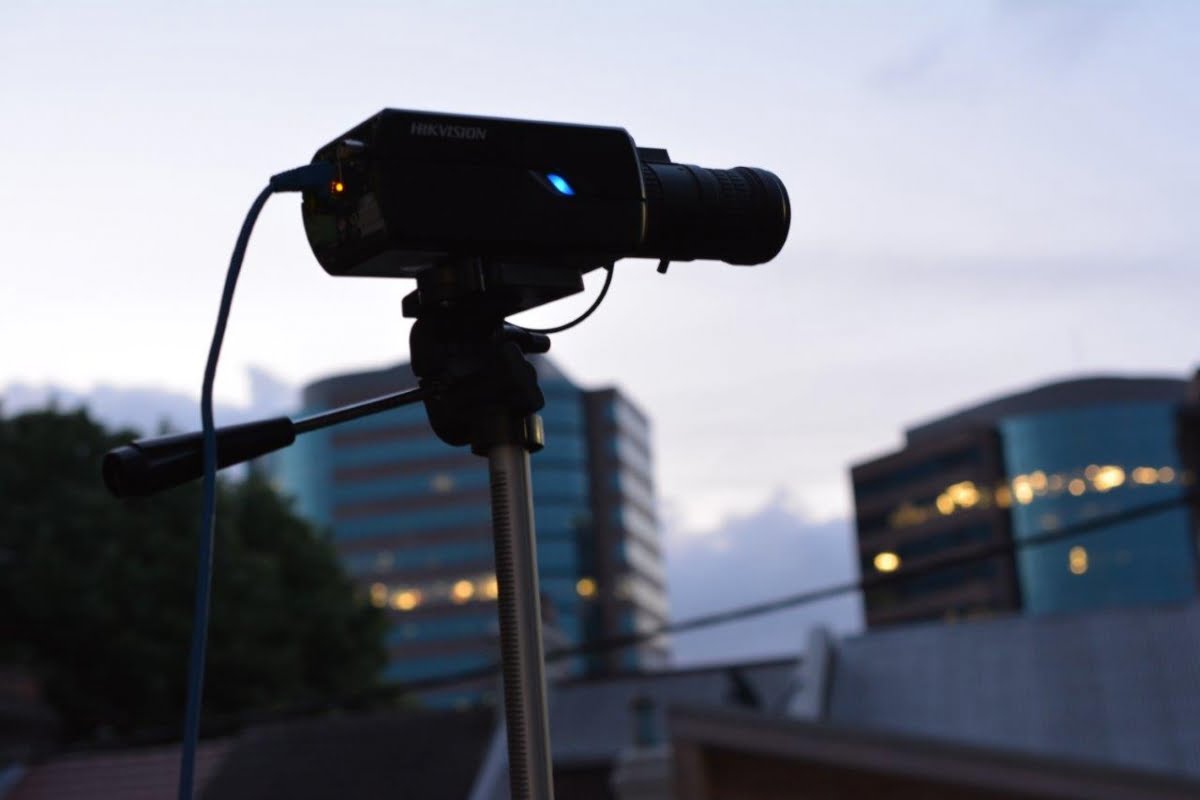
At 615pm the light is down to 10.6 EV (3600) and I decide to dedicate the rest of the twilight period to playing with Darkfighter. I start with the tele and after running back and forth between camera and monitor twiddling the lens focus I work out what remote monitors are used for. Phew. With the tele on, as the light fades, I’m starting to lose a little colour in the district scene but contrast actually seems to improve.

It’s nearly 7pm (summer time) and the wind has dropped off – less scene movement gives more overall detail. Centrepoint Tower is top right at 1500m
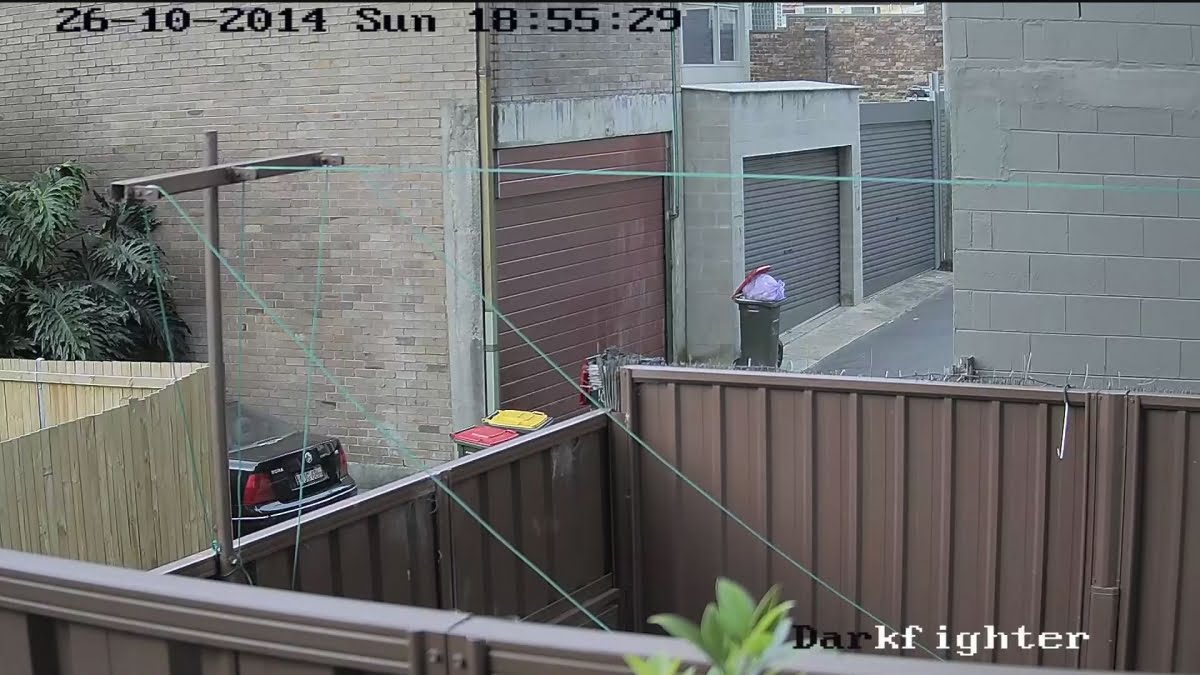
This image was taken just before 7pm with the tele lens. Look at the detail in the brickwork and garage doors – the far brick wall is at 40m. It looked much darker to the naked eye
At 8.6 EV (900 lux) I push the camera lens down into the laneway and it’s a nice, tight and bright image with loads of gritty detail. At 7.23pm we are at 5.6 EV (114 lux) – I still have the tele on and I have to go out and check to make sure it’s actually dark in the laneway out back. The image seems weirdly disconnected from reality – it’s dark outside but the image is still bright. The depth of field has stayed really strong. I decide to keep the tele on until it’s darker and see how it goes.
At 730pm it’s 3.3 EV (26 lux) and there’s a very little yellow haze around the street light in the lane but the image front to back is oddly good. At 735pm it’s 2 EV (10 lux) and the image is still strong. Contrast is softening and there’s a little ‘swim’ in the image but no visible noise snow and I’m still getting colour, though the tones are towards sepia. When I reposition the camera closer to the low pressure sodium street lamp the scene seems far more brightly lit.
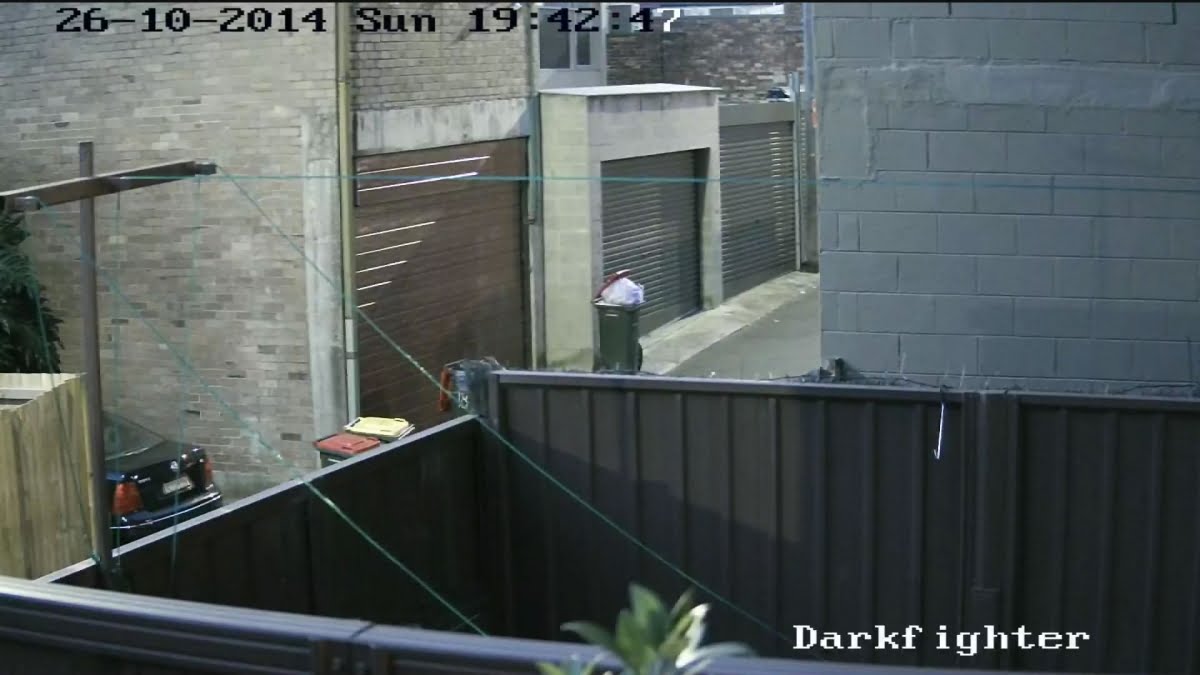
Getting on to 745pm. Good detail everywhere despite low light in front of the lens and in the lane
My first walk at 745pm I measure .1 EV at the lens (about 2 lux) and 1.6EV in the lane (7 Lux). What’s odd though, is that the camera is doing so well in the foreground. There are leaves visible in the spill light from the office, although I’m measuring only 2 lux in front of the lens.
This is a very useable image with only ambient street light support. The amount of detail the Darkfighter is manufacturing in the wall of the Yaffa building is something to see. The image is consistent throughout, too, despite the fact that in reality, this scene has a pool of light under the street lamp and nothing much else but light from neighbouring windows. And when I stand at the camera and look out, the scene is dark to my eye.
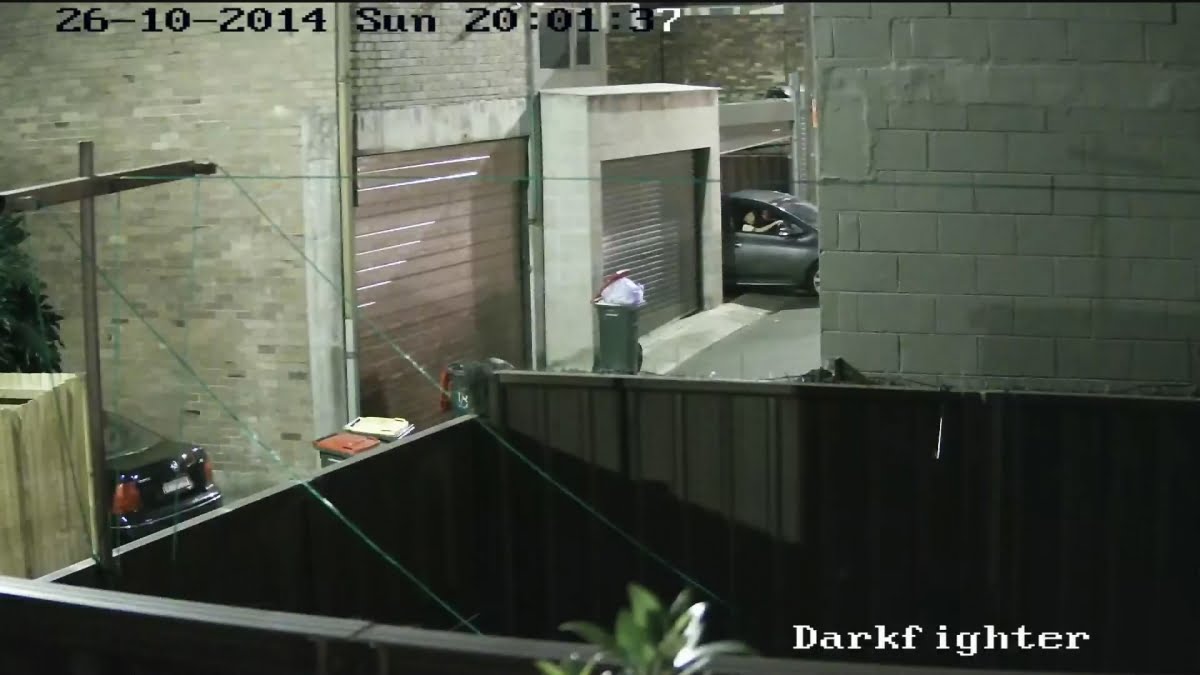
The car in this image is around 25m. Detail is still good at 6 lux. No sign of black and white!
Now it’s 8pm and as dark as the night is likely to get. I do a final walk and a last test of the light in the lane – it’s down to 1.4 EV (6 Lux).
It’s at this point I switch the camera lenses from tele to wide and with the wide angle lens installed the DF blows me away. The image in the courtyard, which to the naked eye is blackness, is being rendered in colour, with serious details.
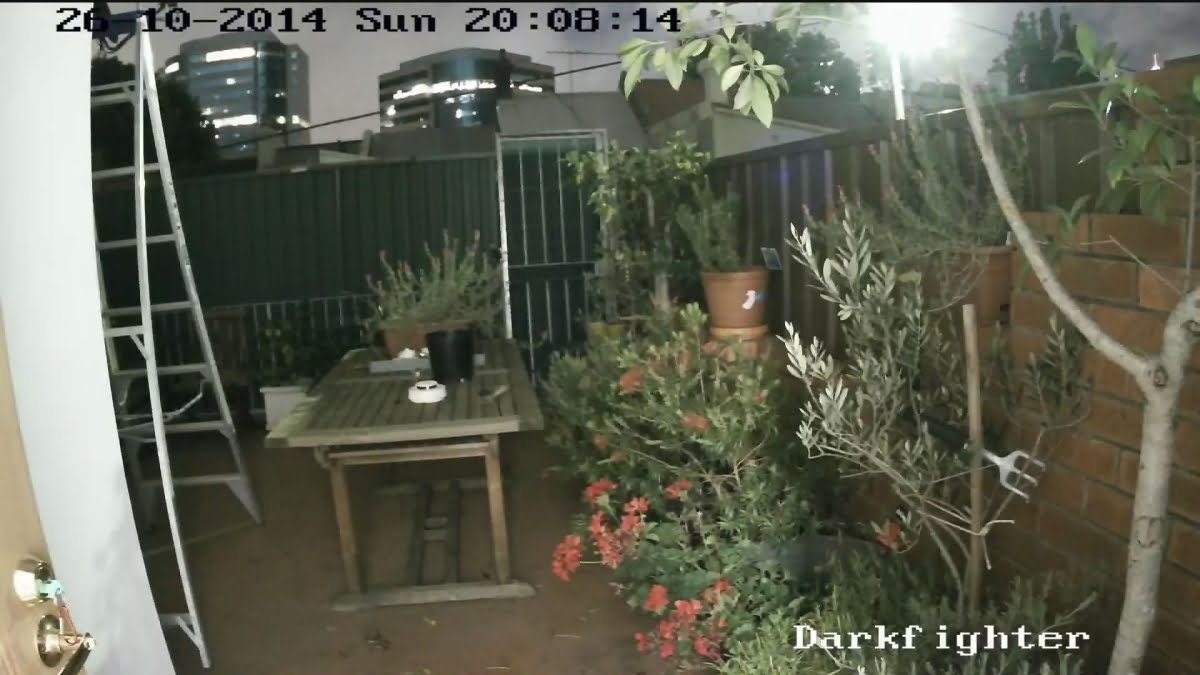
This image misrepresents how dark it actually was in the courtyard. The kitchen light is not near the door, nor is it visible from the doorway looking back
I’ll fix you, you bastard, I think to myself, turning off the adjacent kitchen light. That’s harder work for the Darkfighter but it still does very well, considering. Next, I turn Darkfighter back into the dark lane with the flare from the street lamp full into its wide angle lens, that’s a harder task but there’s still full situational awareness. Not surprisingly, the wide angle is better in the dark and depth of field is good, too.

This image shows Darkfighter soaking up reflected light. It was completely dark to my eye
Next, I drag Darkfighter through the office and plonk it outside looking at Bellevue Street. Ambient lighting here is a couple of street lights and internal lights from houses around about. On the street I measure a skimpy 1.9EV (9.5 lux) but on the monitor the scene is really excellent. There’s colour, contrast and detail – even face recognition at closer ranges. And the depth of field is a real eye opener, too.
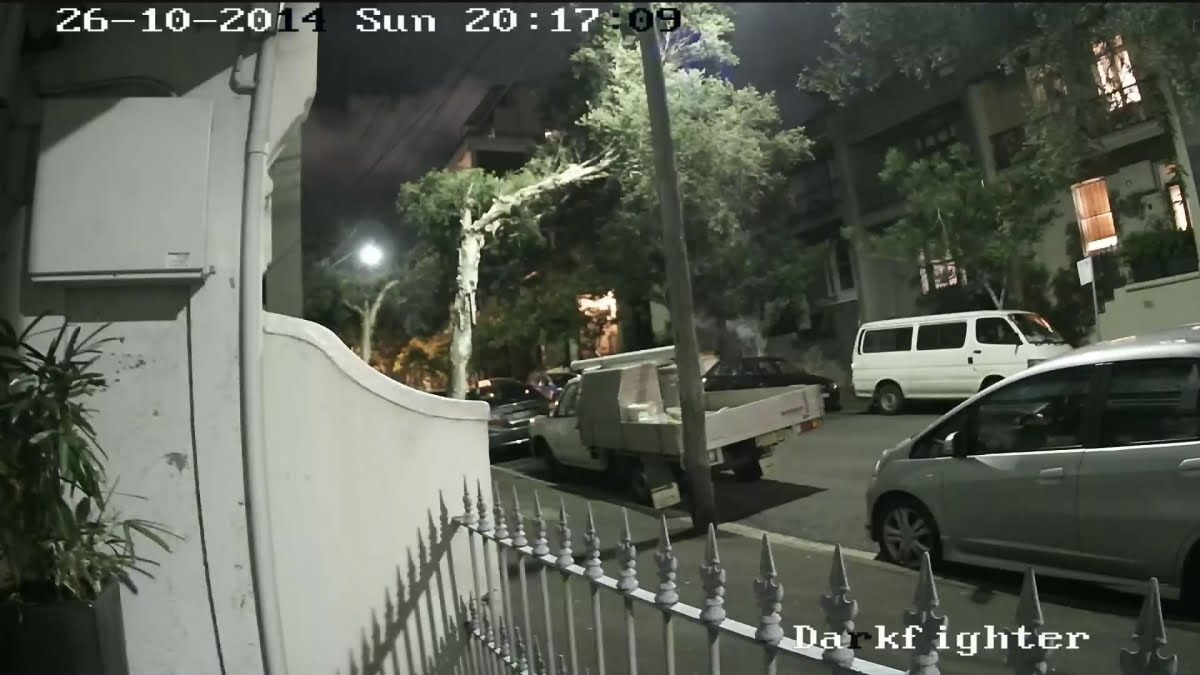
This is the wide angle lens and it’s doing very well out the front in 9 lux
Looking at the monitor, I think Darkfighter does best between 5-10 lux. At around 7-8 lux, when other cameras are getting lost in a snowstorm, Darkfighter starts singing and dancing. The image is brilliant at 7 lux. And it’s much stronger than competitors under 6 lux, in my opinion. You are nearly getting court-admissible face ID at 10m distance in 6 lux, which is the point other cameras are giving up the ghost. Darkfighter seems to slurp up whatever available light it can off walls, from windows. I never saw black and white at any point in this test.
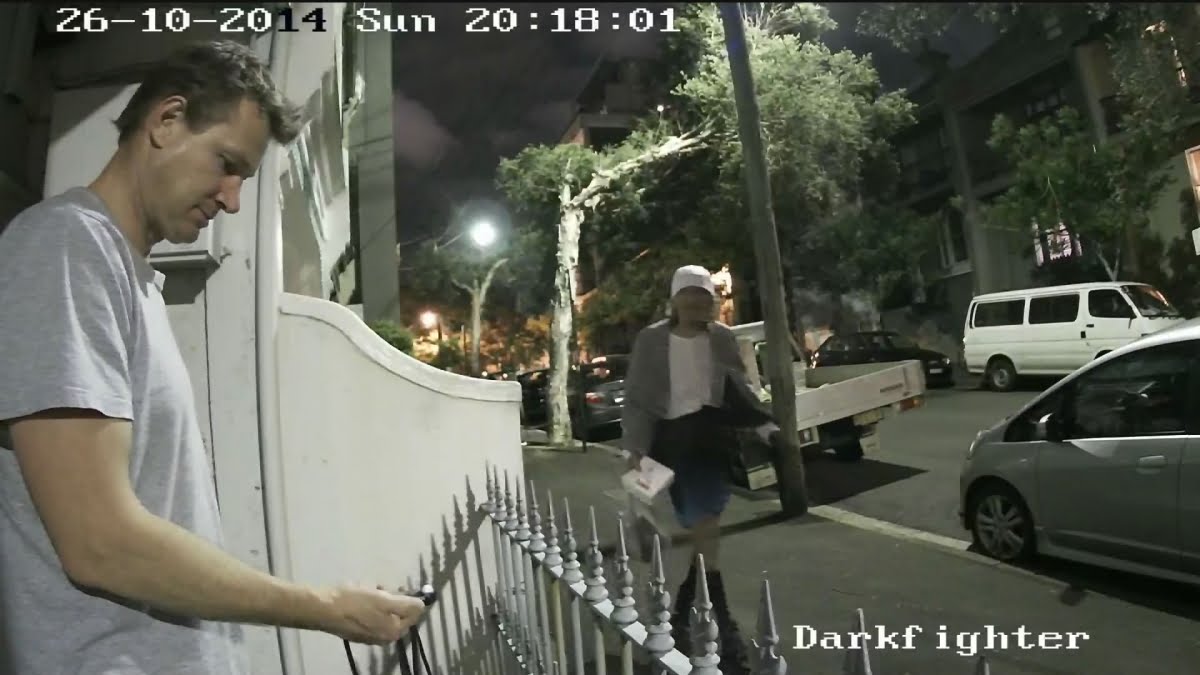
I’m 2.5m from the lens, the first paperbark tree is 12m away. A higher bit rate would have given more detail
In this city location there’s too much ambient light to go under 6 lux without taking the camera inside and turning off the lights but I’ve seen images at under 1 lux externally that suggest it’s probably the best performing low light unit on the market today. And that’s not bad for a camera that handles sensor-frying levels of WDR without turning a hair.
By John Adams
Darkfighter with Darkeye SLA Lens Review
Features of Hikvision Darkfighter include:
* 2MP 1080p Day/Night 60fps
* ½-inch progressive CMOS
* 120dB WDR
* 3D DNR (Digital Noise Reduction)
* Defog feature
* ROI codec
* Audio/Alarm I/O
* PTZ, bullet and fixed dome coming soon.



